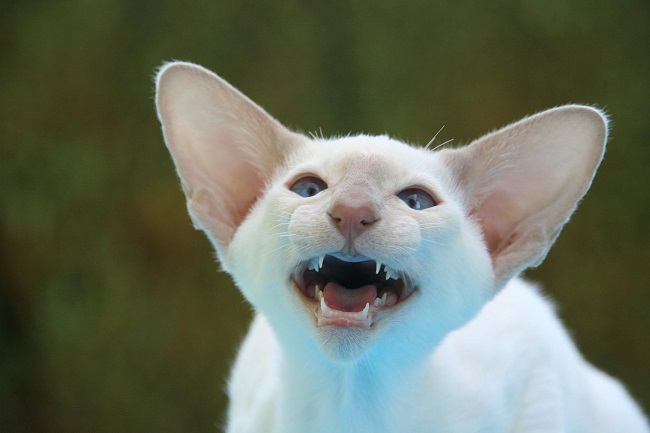The feline world is full of diversity, with cats coming in different sizes, colors, and shapes. One feature that particularly stands out in some breeds is their impressively large ears. So, what’s there to know about big-eared cats?
This article dives into the unique world of these distinctively featured felines, exploring their characteristics, common breeds, and how to care for them.

The Enchanting Allure of Big-Eared Cats
Cats with large ears not only look adorable but also have a unique allure. Their oversized ears, contrasting with their head size, add a certain charm that makes them irresistibly attractive to many cat enthusiasts. But it’s not all about the looks. Large ears also enhance a cat’s auditory and hunting abilities.
Read Also:
Breeds of Big-Eared Cats
Several cat breeds are known for their pronounced ears. Here are some popular big-eared cat breeds:
Savannah Cats: A hybrid of a domestic cat and a serval (a wild African cat), Savannah cats have inherited the large, high-set ears of their wild ancestors.
Oriental Shorthair: Known for their strikingly large ears and almond-shaped eyes, Oriental Shorthairs are one of the most distinctive big-eared cat breeds.
Cornish Rex and Devon Rex: Both these breeds possess notably large ears, contributing to their playful and elf-like appearance.
Siamese: While not the largest in the cat world, Siamese cats have noticeably large, pointy ears that contribute to their overall elegance and sophistication.
Understanding the Function of Large Ears in Cats
Big ears in cats aren’t just for show. They serve essential functions:
Enhanced Hearing: Large ears can capture more sound waves, enhancing a cat’s already remarkable hearing abilities.
Better Hunting Capabilities: In the wild, a cat’s large ears help locate and hunt down prey more efficiently.
Regulation of Body Temperature: Big ears also aid in body temperature regulation, as they dissipate heat, keeping the cat cool.
Caring for Big-Eared Cats
Caring for big-eared cats involves some special considerations. The large surface area of their ears makes them prone to accumulating dirt, debris, and parasites. Regular check-ups and gentle cleaning can help prevent potential ear health issues.
However, avoid deep cleaning, as it can cause damage to their sensitive ears. Always consult a vet for any serious ear concerns.
Distinctive Traits and Personality of Big-Eared Cat Breeds
Different cat breeds with large ears have unique personalities and traits. Here’s an insight into some of these felines.
Savannah Cats: These cats are known for their high energy levels, curiosity, and dog-like characteristics. They’re intelligent and can be trained to do tricks or walk on a leash.
Oriental Shorthair: Oriental Shorthairs are very affectionate and vocal. They are also highly sociable, enjoying the company of their human families and even other pets.
Cornish Rex and Devon Rex: Both these breeds are playful and active. They love to jump, climb, and explore. They’re often referred to as the “clowns” of the cat world due to their mischievous and playful nature.
Siamese: Siamese cats are known for their intelligence, strong bonding with their human companions, and their vocal nature. They’re often described as “talkative,” as they won’t hesitate to communicate their needs or thoughts to their owners.
Understanding the Genetics of Big Ears in Cats
The size of a cat’s ears is determined by its genetics. Big-eared cats inherit this trait from their parents. In some breeds, like the Savannah cat, the large ears can be attributed to wild ancestors with similar characteristics.
While this trait can be dominant or recessive, depending on the breed, it’s generally a well-preserved characteristic in certain cat breeds due to selective breeding.
Preventing Ear Problems in Big-Eared Cats
The large surface area and deep canals of big ears can make a cat more prone to ear issues such as ear mites, infections, and wax buildup. Here are some preventative measures:
Regular Check-ups: Regular veterinary check-ups can help detect any potential ear problems early, ensuring timely treatment.
Proper Cleaning: Regular, gentle cleaning with a vet-recommended product can keep a cat’s ears clean. However, it’s important not to insert anything into the cat’s ear canal, as it can cause injury.
Parasite Control: Keeping up-to-date with flea, tick, and mite treatments can help prevent infestations that can affect a cat’s ears.
Big-Eared Cat Rescue and Adoption
If you’re fascinated by big-eared cats and considering bringing one home, consider adopting a cat from a rescue center. Many big-eared cats, both purebred and mixed breeds, are waiting for a loving home.
Adoption not only provides a home for a needy animal but also helps combat the issue of pet overpopulation.
Adopting a big-eared cat can be a fulfilling experience, giving you a unique companion while offering a deserving feline a second chance at a happy life. Regardless of whether your cat is purebred or a mixed breed, the love and companionship they offer are beyond compare.
Read Also:
Conclusion
Big-eared cats, with their unique charm and distinctive features, are truly a sight to behold. While they require some specific care related to their large ears, the joy and companionship they bring are indeed rewarding.
If you’re an enthusiast of these unique felines, this article should have given you a deeper understanding and appreciation of the extraordinary world of big-eared cats.
Remember, every cat, regardless of the size of their ears, deserves love, proper care, and respect. In return, they will grace your life with endless affection and companionship.
























